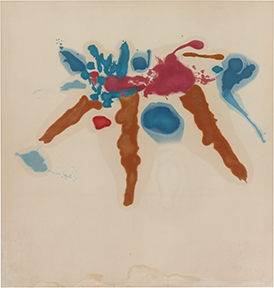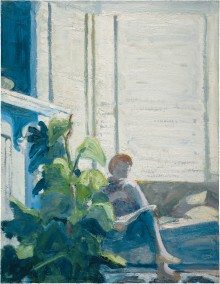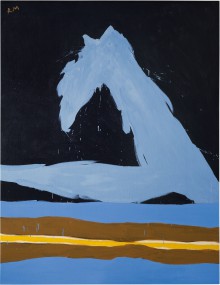Helen Frankenthaler
Approach 1962

© 2014 Helen Frankenthaler Foundation, Inc. / Artists Rights Society (ARS), New York. Reproduction, including downloading of ARS member works is prohibited by copyright laws and international conventions without the express written permission of Artists Rights Society (ARS), New York.
Audio Description (02:53)
Full Audio Transcript (Expand)
Approach
Approach by Helen Frankenthaler was made in 1962 using the innovative and distinctive technique she created called “soak-stain.” Typically, when an artist uses oil paints, they would prime the canvas first to smooth the surface and help the paint stick where the artist puts it. Frankenthaler worked with huge, unprimed canvases. To create this painting, she laid an unprimed canvas on the ground. Instead of applying thick oil paint with a brush, she poured it directly onto the canvas. Where the paint pooled the most, it soaked in, creating dark, richly saturated areas of color. Around the edges of this pooled paint, some would spread out a bit and stain the canvas with an oily whisper of color that grows fainter as it spreads further.
This painting has warm tones in dark gray-blue, brownish rusty orange, dark pink, and burgundy red on a tan canvas that is about seven feet wide and eight feet tall. The painted forms take up almost all the space left to right. They reach close to the top edge, but below, nearly a third of the canvas is blank save for some staining near the bottom. This large unpainted area gives the forms breathing room and the sensation that they might continue to spread and stain the canvas even now, hanging on a wall. It feels less like negative space and more like an area of possibility.
All of the painted forms come into contact with others or nearly so. They are intentionally abstract, organic shapes, although it would be difficult to not try to find familiar imagery within them. The main body is pink and red and shaped like clouds with droplets of the same colors bursting from them in all directions. Two long, thick rusty orange legs spread downward, gnarly and bumpy like tree branches, and a third reaches out like an elephant trunk with its tip that can grab and grip things. Near the tip of this imagined elephant trunk is a blue splotch with dotted drips spraying off of it as if it were water the elephant trunk just sprayed. There are three other substantial areas of blue: a series of thick lines and pools at what might be the head and chest of this possible figure, a disc floating below the belly area, and an arcing form behind, with droplets that escaped and landed on the back leg. A ruby red blob rests between what could be the trunk and the front leg, hovering like a jewel on an invisible necklace. A lone line of the rusty orange stretches out from the back of the red-cloud body like a tail, though it does not connect to anything besides some of the red drips.
Given how abstract the painting is and how the shapes created themselves through soaking and staining and not the artist’s brush, a future visit might reveal something different from the two-legged elephant and clouds, and each interpretation or imagined figure would be as meaningful as the next.
“There are no rules. That is how art is born, how breakthroughs happen. Go against the rules or ignore the rules. That is what invention is about.”
-Helen Frankenthaler
Redefining Feminism in Modern Art
While at the forefront of the Color Field Movement that focused on experimenting with color, saturation, and media, Frankenthaler’s career was constantly entangled with her gender. Works such as Approach— which utilized her groundbreaking soak-stain technique where she would lay paint on unprimed canvases and let it soak in to create hues.were derogated as “blown-up paint rags” by art critic Clement Greenberg and were called “so good that you wouldn’t know it was made by a woman” by the artist Lee Krasner. In addition, her technique was appropriated by Kenneth Noland and Morris Louis after a studio visit in 1953, and it wasn’t until the 1990s that Frankenthaler would gain broad recognition as its creator.
Approach was made at a time when Frankenthaler was trying to separate herself and her art practice from such destructive criticism. After her color schemes were gendered and her process sexualized by critics, she actively moved away from her position as the feminist spearhead of the New York School. Her color schemes shifted to blues and browns. In Approach, the hues and halos of blue, brown, pink, and red work symbiotically to create an aura of a figure suspended in negative space. The layers of paint are fluid even in suspension, playing with our search for a figure in the work.
—Irmak Ersoz ‘24






